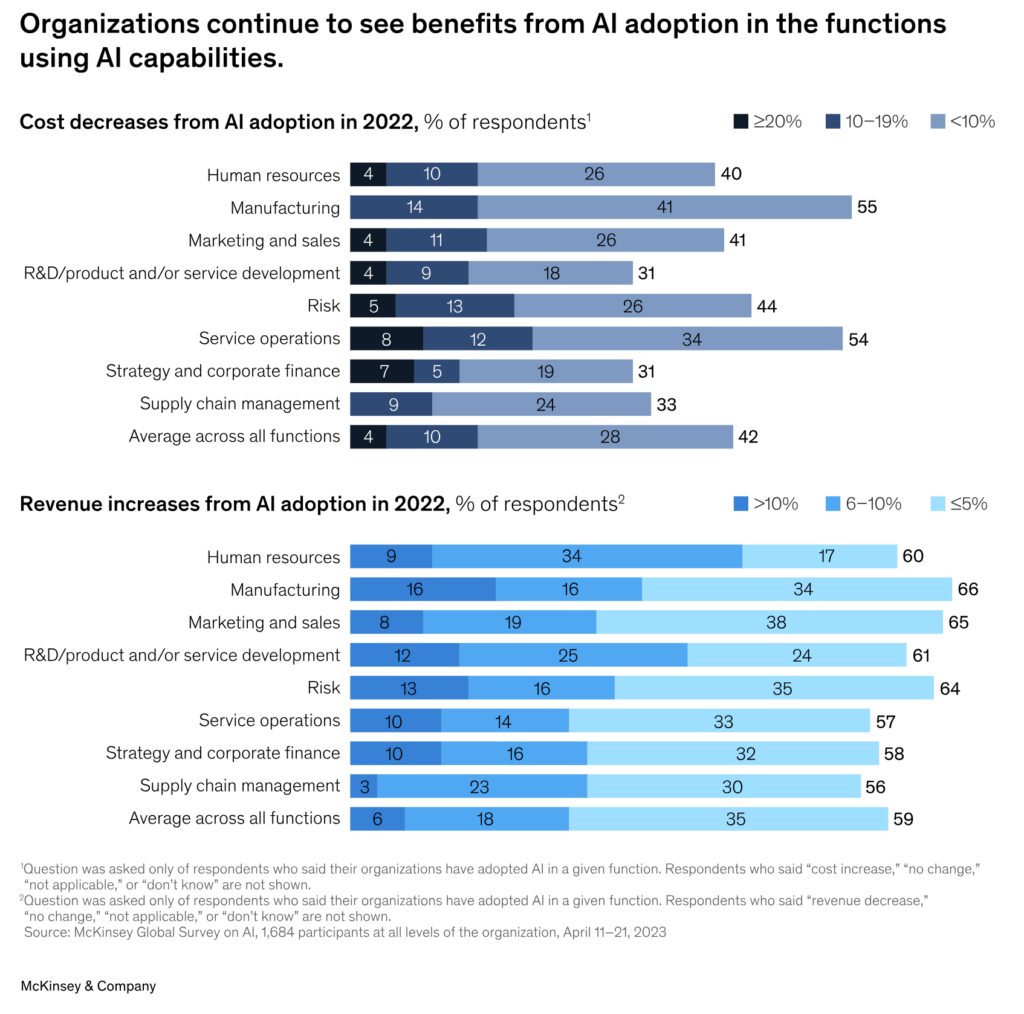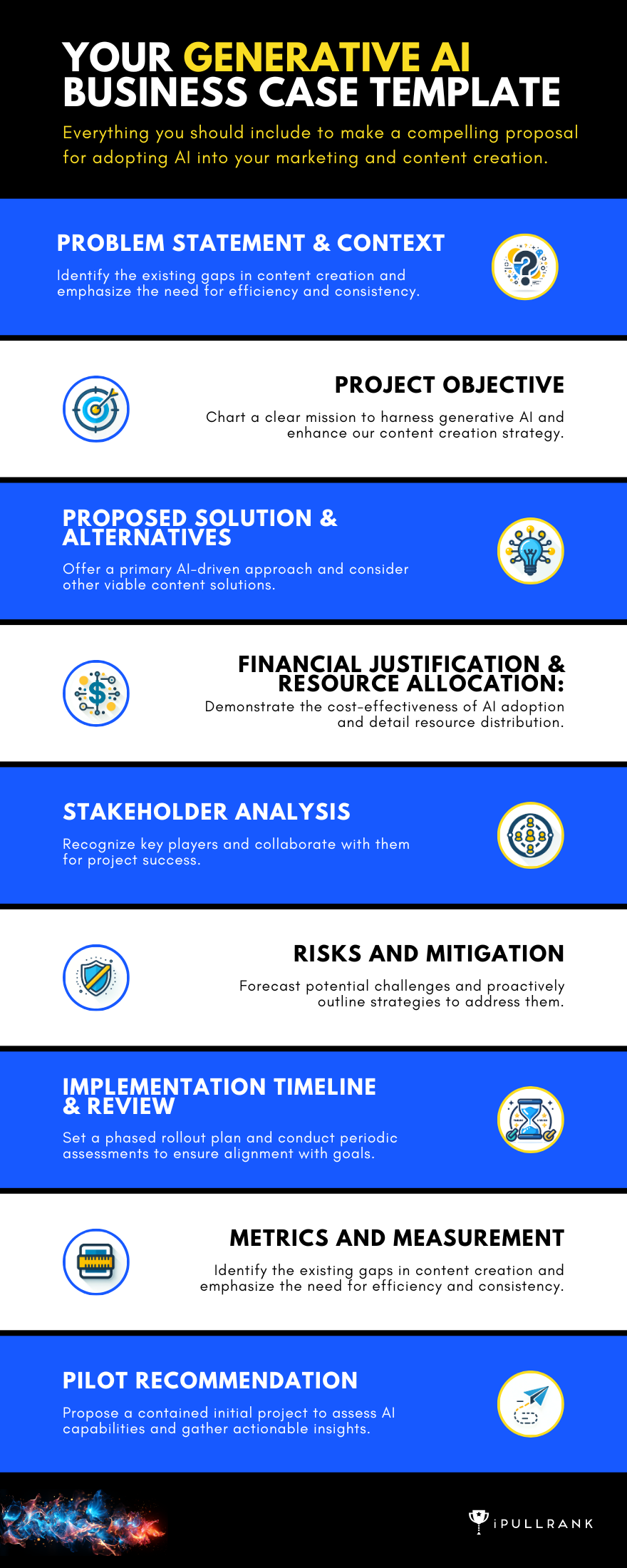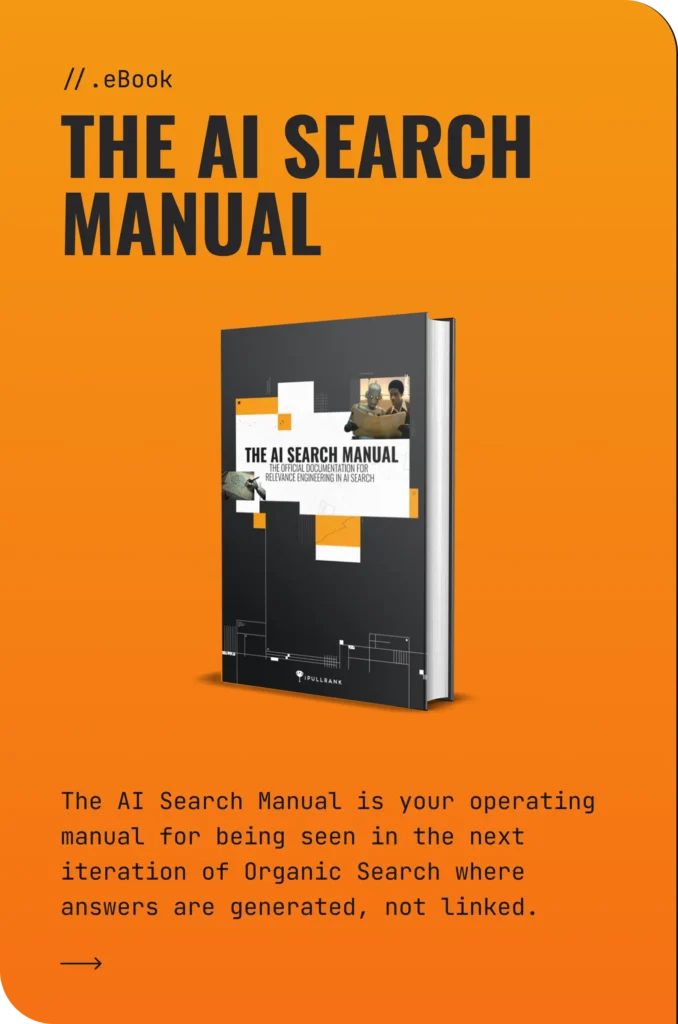Are you going to be the one to bring generative AI to your business?
While a hefty chunk of the business scene remains in AI’s waiting room, you’re the one who understands the opportunity. Sure, you might encounter a few raised eyebrows from senior leadership—navigating uncharted waters does come with its skeptics. My boss still calls out my proposal for NFTs. Trust me, this is different.
With a rock-solid business case and select key executives backing you, you’re poised to get your plan implemented. You could set in motion the big idea that shepherds your organization ahead of your competition.
Table of Contents
Understanding Your Position: Your Organization's Perspective on AI
Before diving into a water cooler rant to your CRO about how ChatGPT can make the company millions, take a strategic pause.
Assess where your company stands on generative AI: is it embraced, sidestepped, or somewhere in between?
Regardless of sentiment, businesses are already seeing the benefits of the tech. McKinsey & Company published a state of generative AI survey that reveals the strength of generative AI in cost efficiencies and revenue growth.

An internal survey around generative AI sentiment and usage backs up your argument with data. If employees are already using tools without an AI policy in place, executives will need to address the topic.
Inventory your current resources, both human and technical. Review every step of your content creation process. Map out specific AI integration points. Consult with execs on budget allocation for new projects. Do you have the opportunity to pitch in the first place?
Most critically, identify the stakeholders. Knowing who’s in the game—and what they bring to the table—will shape the trajectory and success of your AI endeavors. Understand the motivations and concerns across marketing, sales, finance, legal, and your own team. Gather this information with formal (or informal) interviews.

Researching Generative AI: Laying the Groundwork for Your Business Case
Before embarking on your business case for generative AI in content creation, thorough research is non-negotiable. Here’s the essential groundwork:
- Scalability: Investigate AI’s prowess in amplifying content production, ensuring you can cater to expansive audiences with minimal manual input.
- Customization: Dive into AI’s potential for tailoring content based on user preferences, maximizing relevance and engagement.
- Efficiency: Ascertain the time-saving aspect of AI, highlighting how human resources can pivot towards strategy and innovation.
- Consistency: Examine AI’s capability in retaining a cohesive brand voice across multiple content avenues.
In parallel, a deep dive into potential risks and ethical considerations surrounding AI in content is imperative. With this holistic understanding, your business case becomes a compelling narrative, rooted in facts and forward vision.
Crafting the Business Case
When discussing strategic differentiation in content creation for large-scale businesses, generative AI holds significant promise.
To ensure it resonates with the C-suite and stakeholders, consider structuring your argument with tried-and-true frameworks like the ROI-centric approach or a Problem-Solution-Benefit outline. Both these methods provide clarity, quantify impact, and highlight strategic advantages.

Here’s everything you need to articulate a compelling case:
Problem Statement & Context
The Problem Statement in your business case needs to define the core challenge and its wider implications. For AI-driven content proposals, it highlights content production pain points and the potential benefits of AI solutions. Real-world data and benchmarks provide context and strengthens its persuasiveness.
🗒 Example:
The problem of inconsistent and time-consuming content creation affects the marketing department, making it hard to produce varied, frequent, and high-quality content.
This impacts the brand’s online visibility, engagement rates, and ultimately, sales conversions. Introducing generative AI for content production could be an efficient solution, streamlining the process and ensuring content meets set standards with reduced human input.
💡 Pro-Tip: Want to tailor the problem statement for your own business? Using real-world data and observations from your company, the problem statement becomes more urgent, relatable, and actionable for stakeholders.
- Quantitative Metrics: Introduce specific data points or analytics that shed light on the current content challenges. For instance, “Over the past year, content production has lagged by 30%, leading to X% drop in website traffic.”
- Competitor Benchmarking: Highlight where competitors might be gaining an edge with AI-driven content strategies. Example: “Competitor A has reported a 50% increase in content output and 20% higher engagement rates since adopting AI-driven content solutions.”
- Operational Limitations: Detail operational constraints that have hindered content production. For example, “Current content creation relies on a team of five, who are frequently overwhelmed with multiple campaigns, leading to delays and inconsistencies.”
Project Objective
The Project Objective serves as the guiding star of a business case, pinpointing the desired outcomes when deploying generative AI for content creation.
Clear and measurable, it lays out the intended improvements in content production, efficiency, and quality. Rooted in precision, this section ensures that all stakeholders are aligned and driven toward a shared vision for the AI-powered future of content.
🗒 Example:
To integrate generative AI solutions into the content creation process, aiming to increase consistency and efficiency in production. This will enhance the brand’s online visibility, elevate engagement rates, and drive higher sales conversions, while also reducing manual input and resource allocation.
The objective is to harness AI’s capabilities to align content strategies more closely with organizational goals and market demands.
💡 Pro-Tip: To make this business case truly resonate with your organization’s unique needs and aspirations, consider integrating the elements listed above. Tailoring the proposal with these specific examples ensures it’s grounded in your company’s reality, optimizing its chances for approval and successful implementation.
Adapt and modify as necessary, shaping the proposal to align perfectly with your business’s context and goals.
- Specificity in AI Deployment: Detail the particular generative AI tools or platforms being considered. For instance, if there’s an AI tool tailored for blog post generation or another for social media content, specify which fits the business’s needs best.
- Alignment with Brand Voice & Strategy: Emphasize how the AI will be trained or adapted to match the company’s unique brand voice, ensuring that the generated content remains authentic and resonates with the target audience.
- Integration with Current Systems: Describe how the proposed AI solution will integrate with existing content management systems, marketing automation platforms, or analytics tools, ensuring a smooth transition and workflow efficiency. This can also touch on training or onboarding processes for staff to familiarize themselves with the new technology.
Proposed Solution & Alternatives
Your “Proposed Solution & Alternatives” section delineates the primary AI-driven strategy recommended for content creation, while also presenting viable alternative approaches. Crucial for a comprehensive business case, it not only highlights our main recommendation but ensures we’ve considered all angles. By evaluating multiple pathways, we empower decision-makers with options, showing that our primary proposal stands out as the best choice among well-researched alternatives.
🗒 Example:
Our primary focus is to leverage generative AI to enhance and streamline our content marketing efforts. Specifically, we’re aiming at:
- Article Content Creation: Use AI to draft initial versions of blog posts based on given topics or keyword inputs. These drafts will then be refined by human editors, speeding up the overall production process and ensuring a consistent publishing schedule.
- Social Media Content: AI can generate catchy headlines, summaries, and post descriptions tailored to each platform’s audience – be it LinkedIn, Twitter, or Instagram. This can enhance our social media presence and engagement without additional manual input.
- Email Marketing Campaigns: Use AI to personalize email content based on recipient behavior and preferences. From subject lines to the body content, AI can help optimize open rates and click-throughs.
- Ad Copy Generation: Implement AI tools to craft ad copies that can resonate with the targeted demographics, testing multiple versions to determine which performs best.
- Search Engine Optimization: Beyond creating content, AI can suggest SEO-friendly edits and metadata, ensuring our content ranks better on search engines and draws more organic traffic.
As we deliberate on the primary solution, we should also explore a couple of alternatives:
- Hybrid Approach: Combine human creativity with AI. Instead of fully automated content generation, use AI for initial drafts and suggestions, with human editors giving the final touch.
- Specific Platform Focus: Instead of implementing AI across all content platforms, we can focus on one, like email marketing, to measure effectiveness before a broader rollout.
Each solution, including the alternatives, has its merits and limitations. While AI offers efficiency and consistency, a hybrid approach ensures human creativity remains at the forefront. Similarly, a specific platform focus can be a safer start but might not leverage the full potential of AI-driven content marketing. It’s imperative to balance immediate needs with long-term strategic goals when choosing the path forward.
The objective is to harness AI’s capabilities to align content strategies more closely with organizational goals and market demands.
While the presented solution provides a solid foundation for integrating generative AI into content creation, it’s essential to understand that it might not encompass all the unique nuances and intricacies of your business.
Every enterprise has distinct content needs, shaped by its audience, brand voice, and strategic objectives. As you propose this AI-driven approach, it’s crucial to mold the solution to fit your specific content aspirations and challenges.
Whether it’s crafting engaging product descriptions, producing monthly newsletters, or scripting video content, the AI’s application should be a reflection of your brand’s unique narrative and goals. Remember, the technology is a tool — how you wield it will define its success in your content realm.
Financial Justification & Resource Allocation
If you’ve never made a business case before, things get messy and sensitive when it comes to budget and money. Ask for help here. Find a financial stakeholder on your side that can walk you through the numbers that support this section of your proposal.
Here’s a guide on what you should be targeting:
- Cost Analysis: Start by quantifying the current costs associated with content creation. This includes salaries, content outsourcing fees, tools, and software currently in use, and any other overheads. Procure this from your finance department or through your project management tools where expenses are tracked.
- Estimated AI Implementation Cost: Identify the direct expenses tied to integrating the AI solution. This will include software licensing or subscription fees, potential hardware costs, and training. It’s best to get quotes from various AI solution providers to get an accurate figure.
- Resource Allocation: Identify the human resources that will be involved in the project. This might include IT for implementation, content teams for training and oversight, and perhaps an external consultant or agency if you’re outsourcing any aspect. Discuss with department heads to get an accurate estimation of people hours required.
- Potential Savings: This is where you highlight the efficiency of AI. By automating a significant portion of the content creation process, how much time and financial resources can be reallocated? Use the current content output and costs as a baseline to estimate potential savings.
- ROI Calculation: Using the above data, calculate the Return on Investment. Your ROI showcases the financial benefits of the project against its costs. It’s a vital metric the C-suite will look at.
A simple formula:

- Presenting Your Financial Case: This is where the rubber meets the road. Structure your financial data clearly and logically. Begin with current costs, then showcase the proposed AI investment, and conclude with potential savings and ROI. Using visual aids like charts or graphs can make the data more digestible and compelling.
In essence, this section should answer the question, “Is this investment worth it?” And, when articulated effectively with precise numbers, it holds the power to sway your stakeholders.
Stakeholder Analysis
To ensure your business case for generative AI in content creation doesn’t end up dead on arrival, find the stakeholders whose support and collaboration you’ll need. These are not just the people who sign off on projects, but those whose daily operations might be impacted or can provide invaluable insights.
In this section, you’ll want to list out the stakeholders and their key responsibilities:
🗒 Example:
Key players:
- C-Suite for support and accountability
- Marketing for execution
- IT for integration
- Finance for budgeting
- Content Teams for direct implementation
💡 Pro-tip: As an aside, the process below will inform the rest of your business case. So despite these interviews and insights not explicitly ending up in your proposal, it’s a fundamental part of the entire project.
- Interview and Internal Research
The preliminary step in a thorough stakeholder analysis is hands-on research. Engaging stakeholders through interviews is the most effective way to gather qualitative information.
During these interviews, it’s essential to dive deep, understanding their perspectives, apprehensions, and potential enthusiasm towards the project.
Questions to Pose:
- What are your primary concerns about introducing generative AI into our content creation process?
- How do you see this change impacting your department’s workflow or objectives?
- Are there any specific results or assurances you would need to see to support this initiative?
- Do you have any past experiences, positive or negative, with similar technological integrations
- Key Players and Their Concerns
- Marketing: Essential for strategizing and executing content campaigns. Their potential concerns might revolve around how AI-generated content aligns with brand voice and overall strategy.
- IT: They’ll be at the forefront of the technical integration of the AI tool. Their concerns will likely be about integration challenges, software compatibility, and potential troubleshooting.
- Finance: Responsible for budget allocations and ensuring ROI. They’ll be primarily concerned with the cost of implementation versus the expected financial return.
- Content Teams: These are the direct users and will have concerns about content authenticity, the balance between AI-generated and human content, and the learning curve associated with new tools.
- Address Concerns Proactively
Once you’ve identified stakeholders and their respective concerns, the next step is to address them preemptively in your business case. By demonstrating that you’ve taken their concerns into account and have solutions or mitigations in place, you’ll be positioning your proposal as both comprehensive and considerate of inter-departmental needs.
In essence, a stakeholder analysis isn’t just about listing departments; it’s about understanding the nuances of their needs and concerns. By incorporating this depth of research and understanding into your business case, you increase the likelihood of gaining widespread support and ensuring the proposal’s success.
Risks and Mitigation
Your “Risks and Mitigation” section rigorously examines potential challenges of integrating generative AI into content creation, while concurrently presenting strategies to address and overcome these hurdles. Essential for any robust business case, this segment ensures that while we’re confidently pursuing innovation, we’re equally prepared for uncertainties, safeguarding the project’s success and the organization’s interests.
🗒 Example:
Risk 1: Over-dependence on Generative AI
- Businesses might lean too heavily on AI, losing the nuanced touch of human creativity.
Mitigation: Implement a hybrid model that combines AI-generated drafts with human finalization. This maintains the benefits of AI efficiency while retaining the critical human touch.
Risk 2: Inconsistency with Brand Voice
- There’s a potential for AI-generated content to occasionally deviate from the established brand voice or messaging.
Mitigation: Set up comprehensive brand guidelines and train the AI model using brand-specific content. Regularly update the model with feedback to ensure alignment.
Risk 3: Overlooked Errors or Inappropriate Content
- Even the most advanced AI can sometimes produce content that might not be contextually apt or might contain errors.
Mitigation: Introduce a mandatory review phase for all AI-generated content. Ensure that content is vetted by seasoned team members before publication or distribution.
Remember, the risks and mitigations presented here might not capture all specific challenges pertinent to your organization. Adjust these based on your own assessment and insights gained from stakeholder interviews, ensuring a tailored approach that speaks directly to your business’s unique circumstances.
Implementation Timeline & Review
For the implementation, remember you’re sketching a blueprint, not drafting a detailed architectural plan. Lay out the phases from a bird’s eye view, capturing the broad strokes of your endeavor. As you clarify the scope of your goals, you’ll naturally adjust and refine this framework. It’s about direction and structure, not minute details.
By regularly evaluating our progress against set benchmarks, we ensure that the integration remains aligned with business goals and promptly address any deviations. This systematic review process ensures that every step forward is calculated, strategic, and informed by real-world performance data.
🗒 Example:
Plan over three distinct phases:
Q1 focuses on AI tool selection and training; Q2 launches a controlled pilot program; by Q3, based on evaluations, we’ll look at broader integrations. It’s paramount to have frequent check-ins and optimizations.
Metrics and Measurement
Metrics and Measurement chart the success trajectory of integrating generative AI for content creation. It lays out clear, quantifiable indicators to assess the impact and ROI of the initiative. By setting concrete metrics, we not only track progress but also hold the project accountable to its goals, ensuring that our investment in AI consistently drives value and enhances content quality. This segment is the yardstick by which the project’s success is gauged, validated, and refined.
🗒 Example:
Evaluate success via metrics such as the rate of content generation, engagement metrics like shares and reads, and the cost-to-output ratio. Regularly juxtapose these against predetermined benchmarks to validate the AI’s contributions.
💡 Pro-Tip: Including a stakeholder in this section is pivotal, as they will be the one ensuring the team remains aligned with the outlined metrics. Their involvement will guarantee accountability and that objectives are met with precision. To make this section more robust and tailored to your unique needs, consider incorporating:
- Custom KPIs: Depending on your business and goals, define specific Key Performance Indicators that resonate most with your objectives.
- Feedback Loops: Establish a system where you continuously gather feedback on the generated content, refining your processes as you learn more.
- Comparative Analysis: Track how AI-generated content performs against traditionally crafted content in terms of engagement, conversion, and other relevant metrics.
Remember, the metrics you select should reflect not just quantitative results, but also the qualitative impact of generative AI on your content processes. Adjust these suggestions to resonate with your organization’s goals and stakeholder expectations.
Pilot Recommendation
Remember, you’re not overhauling your entire content strategy. Starting small allows for clearer evaluation, efficient troubleshooting, and gradual stakeholder buy-in. Here are three feasible pilot projects to consider:
- AI-Enhanced Article Content: Task the AI with generating first drafts or outlines for a series of articles on a niche topic that’s low stakes for the business with significant potential. Human editors can then refine and align these drafts to the brand’s voice, ensuring quality and authenticity.
- Email Marketing Campaigns: Utilize AI to generate subject lines, content snippets, or even A/B test variations for a targeted email marketing campaign. By comparing AI-generated results with traditional methods, you can gauge effectiveness and potential scalability.
- SEO-Driven Content Enhancement: Use AI to optimize existing content pieces for SEO. This can involve generating improved meta descriptions, alt tags, or suggesting header modifications based on prevailing best practices and search intent.
Each of these pilot projects offers a contained environment to test the waters, assess the AI’s capabilities, and gather real-time feedback. Select a project that aligns closely with your business’s immediate goals and current content challenges.
Propose your narrowly defined pilot on a key content channel. Post-success evaluation, consider a broader rollout.
Refine Your Proposal and Set Your Presentation Date
We’ve mapped out a clear path for integrating generative AI into our content operations.
Now, it’s about action. Review the proposal with your key stakeholders – their feedback is invaluable. Once refined, lock in a presentation date.
Ensure everyone, from team leads to C-suite members, is present. Their understanding and buy-in will be instrumental in turning this proposal into a successful initiative. It’s time to put generative AI in front of the C-suite and bring the tech to your business. Let’s get started.
Need a Partner for Your AI Journey?
If you’re seeking a vendor to guide and support your project, iPullRank is here to help. Our generative AI services align perfectly with everything detailed in this proposal. Ready to make strides? Set up a call with us today.







